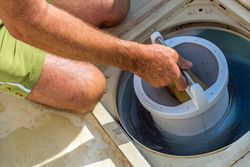
If you own a swimming pool, you know that your filter works around the clock to keep your pool clean and clear. It circulates the water to prevent stagnation while removing algae spores, bacteria, dirt, oil, and other pollutants that create cloudy, unhealthy water. If you are in the market for a new filter, you need to be aware of the three most common types and which could be right for your swimming space.
3 Types of Swimming Pool Filters
1. Sand
These are the longest-lasting filters and consist of a large filtration tank filled with particle-trapping sand, a silica bottom, and crushed grass. The rough edges on each grain of sand help trap debris, but years of water flow cause the edges to smooth. So this will need to be replaced regularly, usually every year. Waste also builds up in the sand, lowering the filter’s efficiency. Weekly backwashing, or when water enters the filter from the opposite direction to dislodge the debris, keep this filter operational.
 The affordability and longevity of a sand filter make it an attractive option if you have a larger pool. Since it does not clog frequently, it rarely requires substantial cleaning or clearing out. However, it requires consistent pool chemistry checks in addition to weekly backwashing because particles and bacteria under 20 microns (micrometers) do not get filtered out and can cause dangerous buildup.
The affordability and longevity of a sand filter make it an attractive option if you have a larger pool. Since it does not clog frequently, it rarely requires substantial cleaning or clearing out. However, it requires consistent pool chemistry checks in addition to weekly backwashing because particles and bacteria under 20 microns (micrometers) do not get filtered out and can cause dangerous buildup.
2. Cartridge
These filter particles 10 microns and above using polyester or similar material, and help conserve water because they don’t require backwashing. Instead, rinse the cartridge with your garden hose every two to six weeks to remove impurities. You can also periodically soak the cartridge in soapy water for a deep clean. However, these cylinder-shaped cartridge options last three years compared to sand filters that last seven.
If you’re looking for an affordable, low-maintenance filter for your small pool, a cartridge filter is best, but you need to take into account the size of your space. Larger pools tend to overwhelm these filters, which can result in the need for frequent replacement.
3. Diatomaceous Earth
These feature grids coated in diatoms, or the minute fossilized remains of aquatic organisms. The diatoms appear as a white, powdery substance that filters pool particles. Usually the most expensive filter, they remove contaminants down to 5 microns. You’ll need to backwash the filter and replace the white powder a few times a year to keep your water clean, and the filter requires replacement every three years.
These fall between sand and cartridge options in regards to maintenance, and are usually used for inground pools only. However, if you don’t mind the expense, they are the best option for clean, healthy swimming pool water.
Discuss the best filter for your swimming pool with All-American Pools in Cincinnati, OH. Specializing in above and in-ground pool installation and maintenance for over 60 years, this company also provides follow-up and restoration services to help you preserve your investment. They will help you evaluate your needs and recommend the best filter for your specific situation. Call (513) 522-7161 (West Side location) or (513) 753-6923 (East Side location) today to schedule service. Visit the website for the latest promotions and like the Facebook page for more pool maintenance tips.
About the Business
Have a question? Ask the experts!
Send your question

